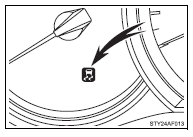Toyota Tacoma (2005–2015) Owners Manual: Active traction control system
The active traction control system automatically helps prevent the spinning of 4 wheels when the vehicle is started or accelerated on slippery road surfaces.
■ System operation
 Vehicles with an automatic transmission:
Stop the vehicle, shift the shift lever to N and put the frontwheel drive control
switch in the L4 position.
Vehicles with an automatic transmission:
Stop the vehicle, shift the shift lever to N and put the frontwheel drive control
switch in the L4 position.
Vehicles with a manual transmission: Stop the vehicle or reduce your speed to less than 2 mph (3 km/h). Depress the clutch pedal and put the front-wheel drive control switch in the L4 position.

Press the A-TRAC switch to activate the system.
At this time, the active traction control system indicator will come on.
To cancel the system, push the switch again.
When the active traction control system is operating

If four wheels spin, the slip indicator flashes to indicate that the active traction control system has been engaged.
■When the rear differential is locked (vehicles with the rear differential lock system)
The active traction control system is activated only when the vehicle speed is less than 3 mph (6 km/h).
■Sounds and vibrations caused by the active traction control system
●A sound may be heard from the engine compartment when the engine is started or just after the vehicle begins to move. This sound does not indicate that a malfunction has occurred in the system.
●Vibrations may be felt through the vehicle body and steering. It may occur when the system is operating.
■If the brake system overheats
The system will cease operation, a buzzer will sound and A-TRAC indicator blink to alert the driver. Stop the vehicle in a safe place. (There is no problem with continuing normal driving.) The system will be automatically restored after a short time.
CAUTION
■The active traction control system may not operate effectively when
Directional control and power may not be achievable while driving on slippery road surfaces, even if the active traction control system is operating.
Do not drive the vehicle in conditions where stability and power may be lost.
 Four-wheel drive system
Four-wheel drive system
Use the front-wheel drive control switch to select the following transfer modes.
H2 (high speed position, two-wheel
drive)
Use this for normal driving on dry hard-surfaced roads.
This position ...
 AUTO LSD system
AUTO LSD system
The AUTO LSD system aids traction by using the traction control system to control
engine performance and braking when one of the rear wheels begins to spin.
The system should be used only when one ...
Other materials:
Heater Circuit (C1AAE)
DESCRIPTION
The forward recognition camera controls the current supplied to the camera heater
(forward recognition hood).
If the forward recognition camera detects a malfunction in the camera heater
(forward recognition hood) circuit, DTC C1AAE is stored.
DTC No.
Detecti ...
Replacement
REPLACEMENT
PROCEDURE
1. RECOVER REFRIGERANT FROM REFRIGERATION SYSTEM
(a) Start up the engine.
(b) Turn the A/C switch to ON.
(c) Operate the cooler compressor with an engine speed of approximately 1,000
rpm for 5 to 6 minutes to circulate the refrigerant and collect the compressor oil
rem ...
Navigation Receiver
Components
COMPONENTS
ILLUSTRATION
ILLUSTRATION
Removal
REMOVAL
PROCEDURE
1. REMOVE INSTRUMENT CLUSTER CENTER FINISH PANEL SUB-ASSEMBLY
(See page )
2. REMOVE NAVIGATION RECEIVER ASSEMBLY WITH BRACKET
(a) Remove the 4 bolts.
(b ...
